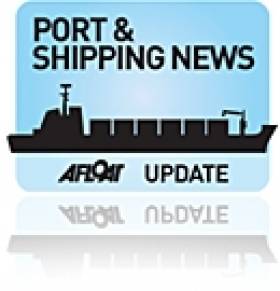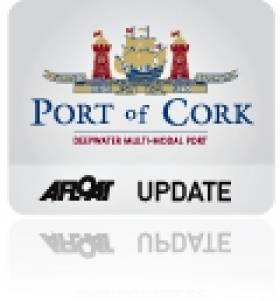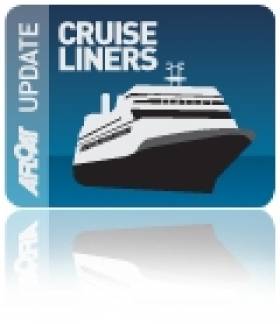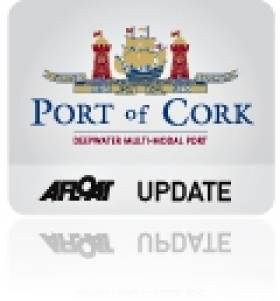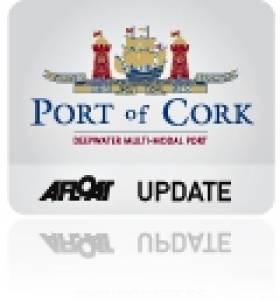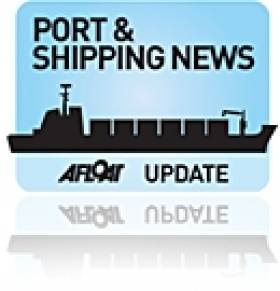Displaying items by tag: port of Cork
More Bananas Head for Cork
#PORTS & SHIPPING – As previously reported on Afloat.ie Maersk Line's newly launched liner service that includes the return of the banana trade to the Port of Cork continues as another shipment is due from Central America /Caribbean ports with the arrival of Nedlloyd Adriana (photo) tomorrow, writes Jehan Ashmore.
Nedlloyd Adriana (2003/ 26,833grt) is a younger sister of Maersk Nolanville (2004/26,833grt) which previously docked at the Ringaskiddy Deepwater Berth as part of the services weekly call. Onboard the 2,500 (TEU) twenty equivalent unit capacity containerships, they include 800 (reefer points) i.e electrically plugged in refrigerated containers to store perishable products.
Noting the cargo deck arrangement is divided by the superstructure, which in vessel design terms is not unusual, but is not normally seen in Irish waters due to this larger sized containership. She is fitted with three deck-mounted cranes positioned forward of the bridge and a single-aft crane to cater for the smaller cargo-deck astern.
The vessel was built in South Korea by Hyundai Heavy Industries in Ulsan and was launched as Adriana Star. She was later renamed P&O Nedlloyd Adriana until dropping her operators prefix in 2004.
When the vessel has completed operations in Ringaskiddy, she heads to UK and continental ports to complete the liner service which is served in total by a pool of eight similar sized vessels.
The term 'liner' service refers to a dedicated regularly operated network of long-distance routes across oceans that connect ports between the continents.
The liner service is complemented by an onward internal network of short-seas routes known as 'feeder' services and use smaller containerships such as Vega Stockholm (photo) which calls to Dublin Port (see BBC The 'Box') as previously reported on Afloat.ie
As in the case of the Maersk Line liner service which brings bananas from source directly to Cork, there is no requirement to transfer such cargo by feeder vessel from another port in the UK or mainland Europe.
The 'Banana' Trade Returns to Cork
#PORT OF CORK – Global shipping giant Maersk Line recently started their first ever direct service to Ireland with a new liner service calling to the Port of Cork and sees the return of the 'banana' trade not last seen in port since the 1970's, writes Jehan Ashmore.
The older 'banana' boats or reefers that used to serve Cork may be long gone but the Danish owned Maersk Line will be operating an impressive pool of eight large contiainerships. They will bring leading banana brands from Central American ports to Europe with Cork being the first port of call in Europe. The liner service starts in the Mexican port of Vera Cruz and includes calls to Costa Rica, Belize, Panama before reaching Cork.
One of the vessels Maersk Nolanville (2004/26,833grt) last week docked in Ringaskiddy Deepwater Terminal, is one of the largest of her type to be accommodated in the port. At 700m long, a beam over 30m and drawing a draft exceeding 10m the South Korean built vessel was too large to berth at the ports Tivoli Container Terminal further upriver on the Lee.
Maersk Nolanville and her fleet-mates will operate with a weekly call to Cork on Thursdays, where quayside cranes in Ringaskiddy will handle the 2,500 (TEU) capacity vessels including around 800 refrigerated containers containing perishable tropical fruits.
Asides bananas the vessels will import other cargoes, with the containerships also calling to Tilbury in the UK and Rotterdam and with exports on the return leg of the long trans-Atlantic voyage home.
IMERC’s Inaugural Conference 2012
#IMERC CONFERENCE - The recently established Irish Maritime and Energy Resource Cluster (IMERC) which is to promote the country as a world-renowned research and development location, is to host next month its inaugural conference entitled 'Maritime Geostrategic Thinking for Ireland'.
Minster for Marine, Simon Coveney T.D. will address the conference at the National Maritime College of Ireland (NMCI), Ringaskiddy, Co, Cork which is to be held on Friday 9th March.
In addition to keynotes speakers addressing the conference are Glenn Murphy (IMDO), Commodore Mellett of the Naval Service, Anthony Gurnee from Ardmore Shipping, Helen Noble, Head of Maritime Law at Matheson Ormsby and Prentice and Professor D John Mangan from the University of Newcastle.
Below is a programme schedule of the conference and additional information and link.
Session 1: Fighting recession by supporting an export led economy
Session 2: Building maritime security capability in support of economic development
Session 3: Future of Maritime Ireland
Session 4: IMERC Industry Engagement
To make a booking and receive further details on the conference contact IMERC Tel: (021) 433 5717 or by clicking HERE.
IMERC is based on the campus grounds of NMCI which is located between the Naval Service Base on Haulbowline Island and the neighbouring ferryport in Ringaskiddy.
Under phrase 1 of IMERC's campus development plans, it aims for the construction of the UCC National Beaufort Centre by May 2013. Phase 2 of the campus is for an extended maritime and energy science and commercial park located on the adjacent Port of Cork owned landbank.
Port of Cork Gets off to a Good Start in 2012
#CORK – January 2012 kicked off to a good start for the Port of Cork with over 76,000 tons of dry bulk animal feeds unloaded in one week, a record for the Port. The high quantity of feed which was unloaded as part cargo from five large bulk carriers, gives a welcome boost to the quantities of dry bulk material handled by the Port of Cork.
In the Republic of Ireland bulk cargoes have seen an increase of 2% across all ports and this growth is a reflection of the growing confidence in the agricultural sector.
Commercial Manager, Captain Michael McCarthy said: "Unloading over 76,000tonnes of dry bulk animal feeds at Ringaskiddy Deep-water Terminal in five days is an excellent boost for the port. It demonstrates the port's capabilities when it comes to handling large ships with efficient and safe turnaround times. Many of the main feed importers are utilising the Port of Cork's deep-water capacity with Panamax vessels arriving fully laden to lighten before proceeding to other Irish or UK Ports"
Cork Cruise Caller Line-Up for 2012
#CRUISE LINERS – The Port of Cork is to welcome 60 cruise vessels this season, an increase on 2011 levels when 53 calls were made, bringing over 100,000 passengers and crew to the region, writes Jehan Ashmore.
According to UK Consultants GP Wild, the average in-transit spend per passenger, while visiting an Irish port is between €73- €100 which provides a significant contribution towards the local tourism economy.
Last year Cork won 1st place for 'Best Destination Experience (Organised)' in the world and 2nd place for 'Best Port Welcome' in the Dream World Cruise Destinations Awards.
Fred Olsen Cruise Lines Balmoral is the first caller for 2012 when she is to dock at Cobh in April. Larger cruise ships to visit during the season include Celebrity Eclipse, Emerald Princess, Independence of the Seas, Costa Deliziosa and Caribbean Princess.
In addition Cunard Line's Queen Elizabeth is to return to Cobh in August. Her inaugural Irish visit was in September last year, when the 90,000 tonnes vessel called firstly to Dublin followed by Cobh, to read more click HERE.
For a list of the cruise schedule, click HERE, noting several calls are to Ringaskiddy and North Custom House Quay in Cork City.
‘Resilient’ Performance by Port of Cork in 2011
#PORT OF CORK - Port of Cork Company chairman, Mr Dermot O'Mahoney, yesterday announced end of year trade traffic results for the Port of Cork in 2011. He said: "Trade traffic has shown remarkable resilience recording 8.8 million tonnes despite experiencing challenging periods during 2011." These figures are on a par with 2010 figures at the Port of Cork.
A remarkable feature of the figures is the very positive effect on the local economy by the increase in exports from the Port. Total exports at the Port of Cork have remained strong increasing by 9% in comparison to 2010 and by 19% since 2009. Exports are a key driver in the successful recovery of the Irish Economy and the Port of Cork is committed to continuous support in the growth of international trade for both current and future economic prospects.
Although the growth in export volumes to pre –recession levels reflects the rapid "V" shaped bounce back by the export sector which was achieved despite the depressed international economic environment, import volumes are still 12.9% below 2007 levels. The continued low volume of imports is inevitably putting huge strain on the ports, shipping lines and transport sector servicing the country.
The container business at the Port of Cork has shown an increase of 5% with over 150,000 TEU handled in 2011. Animal feed stuffs, fertiliser and other trades have shown a marginal decrease in 2011. Oil traffic has remained steady despite the lower levels of domestic economic activity; however exports of refined product from Conoco Phillips Whitegate Oil Refinery has remained strong and continues to be a significant part of the Port of Cork business.
Remarking on the end of year trade traffic results, Mr Dermot O'Mahoney Chairman of the Port of Cork said: "The Port of Cork is pleased to announce that total trade traffic in 2011 has remained strong with exports increasing by 9% over 2010 volumes. With 98% of all goods imported or exported from Ireland moved by ship, the importance of ports to our economy is of vital strategic importance. The Port of Cork is a key link to the continued economic success of Ireland and in particular the entire Munster region. The challenge now facing the Port of Cork is to continue to develop to meet the needs of the Country as it emerges from this current recession. This requires that we be visionary and seize opportunities presented by emerging trends and logistic supply changes."
He continued: "While the next four to five years will be challenging for us all, we need to continue to promote the fact that Ireland is an excellent investment location and is well placed to capitalise on growing global markets as is evident by our export sector."
53 cruise vessels visited the Port of Cork during 2011 bringing over 100,000 passengers and crew to the region and the Port is scheduled to accommodate 60 vessels in 2012. According to research carried out by UK Consultants GP Wild, the average in-transit spend per passenger, while visiting an Irish port is between €73- €100 which provides a significant contribution towards the local tourism economy. In 2011 the Port of Cork won 1st place for 'Best Destination Experience (Organised)' in the world and 2nd place for 'Best Port Welcome' in the Dream World Cruise Destinations Awards. This achievement highlighted the outstanding team effort and commitment by the Port of Cork to deliver an excellent service to the visiting cruise lines and their passengers when in Cork. Ireland Inc. also received a Commendation as a "Destination where the Quality and Professionalism of Tour Guides is considered outstanding".
Port officials are pro-actively engaged with tourism interests, County and City Councils and destination attractions to enhance the product on offer to the visiting cruise lines with a view to growing the business further through its dedicated cruise terminal.
Ferry passenger numbers with Brittany Ferries remained steady on its weekly ferry service from Cork to Roscoff and the Port awaits the outcome of the Examinership of Fastnet Lines and the re-commencement of the ferry service linking Cork with Swansea.
The Port of Cork's recreational strategy continues to expand with the aim of improving the marine leisure facilities around Cork Harbour.
Mr O' Mahoney concluded by saying that "the Port of Cork must continue to reinforce its existing strength as the primary deep-water port in the south of Ireland and build on our progress so far by effectively resolving our challenges in an imaginative way and with a strong sense of urgency and determination."
Port of Cork to Submit New Container Terminal Plans
#PORT & SHIPPING NEWS - The Port of Cork is scaling down its plans for a new container terminal in Ringaskiddy, according to the Irish Examiner.
The new plan is "significantly scaled back" from the €220 million containter terminal proposal for Oysterbank, which was rejected at appeals stage two years ago.
Port officials hope to submit the new application under the Strategic Infrastructure Act, which means the decision will be made by An Bord Pleanála and not Cork County Council.
Officials are already in consultation with the planning board and interest groups around Cork Harbour to eliminate any issues before proceeding with the new scheme, which will be half the size of the previous plan and will involve less land reclamation.
Expected upgrades to the roads infrastructure in the area will also have an impact on the new proposals.
The €100 million plan would be constructed over four phases, to be fully operational by 2020.
The Irish Examiner has much more on the story HERE.
National Commemoration Services for Irish Seafarers
#EVENTS-The annual Seafarers Commemoration in Cork will be held at 12 noon, on 28th November in the Port of Cork Offices, Custom House Quay.
The event is organised by the Cork branch of the Maritime Institute of Ireland which also hosted the Seafarers Commemoration in Dublin last Sunday where a mass was held at City Quay Church. Wreaths were laid afterwards at the nearby Irish Seaman's National Memorial, for the men of the Irish mercantile marine who lost their lives at sea during the Second World War.
In the afternoon, a commemoration service of those who lost their lives on Irish ships also took place at Evensong in St. Patricks Cathedral.
As the 'family of the sea' gathered at the City Quay memorial, this provided an opportunity to reflect memories of former seafarers. In recent years, the memorial service has been extended to honour all Irish seafarers who have died at sea.
For further information detailing lists of Irish merchant ships lost during WW2 and the names of those seamen lost, click HERE in addition a short video clip depicting war footage and paintings of Irish vessels lost.
Yesterday marked the 20th anniversary of the sinking of the B&I Line containership Kilkenny in Dublin Bay in which three crew lost their lives in a collision with the German owned Lo/Lo Hasselwerder.
A memorial to the incident in 1991 is located at Irish Continental Group's (ICG) headquarters in Dublin Port, where the former state-run B&I Line was based before privatisation and sold to ICG's ferry subsidiary Irish Ferries.
Export Industry Awards to Deep and Short Sea Shipping
Eucon Shipping and Transport Ltd won the Short Sea Shipping Company of the Year Award 2011, sponsored by the Irish Maritime Development Office (IMDO), which recognises the strategically important role of short sea shipping to our economy. Eucon offers Irish exporters access to worldwide markets via its regular feeder services to Rotterdam, Antwerp and Southampton operating from the ports of Dublin, Cork and Belfast. The other nominees were: CLdN RoRo S.A. and Grimaldi Lines.
In the category for the Logistics Company of the Year Award 2011, sponsored by Dublin Port Company, the award went to Caffrey International. The Co. Meath based company is a specialist provider of road transport and logistics services between Ireland, the UK and continental Europe.
The award recognises the importance of logistics and supply chain management firms to the exporting effort of companies trading internationally from Ireland. The other nominees were: DHL Global Forwarding (Ireland) Ltd., Dublin; Eucon Shipping and Transport Ltd. and Geodis Ireland Limited, Dublin.
ABC Nutrition of Shannon was presented with the overall award of the Exporter of the Year Award 2011 after winning in the Emerging Markets Exporter Award, one of twelve categories which were presented at the ceremony.
Restructured Fastnet Line Reduce Year Round Service to Seasonal Schedule
The discontinued winter sailing schedule for this year is also expected not to be repeated during October 2012-March 2013. Fastnet Line's decision to make the Celtic Sea route into a shoulder season and summer only service follows a similar path taken by Stena Line which withdrew Dun Laoghaire-Holyhead (HSS) sailings in mid-September, for report click here. The central corridor route is due to reopen sometime in April or May 2012.
Cork City and County council and Kerry County council have provided €700,000 to support Fastnet Line and yesterday they announced an additional €150,000 in co-funding for the period of the examinership. In order to stabilise finances the ferry company are to radically reduce passenger capacity of the Julia (see photo) from 1,500 down to 950. This is in line with the capacities of the Julia serving 'night' sailings.
She has a crew predominately from Eastern Europe and Irish and UK deck officers. The Bermuda flagged, Hamilton registered vessel is currently berthed at Ringaskiddy Ferry Terminal, Cork Harbour. At 154m she is the largest ferry to date capable of berthing in the limited confines of the swing basin in Swansea and with a draft of 5.8m in a port which is subject to a large tidal range on the Bristol Channel.
Operating costs on the 10 hour service has been severely hampered by continuing increases to world oil prices. From the year 2010 to this year, fuel costs rose by 27% and almost 50% from the original budget of 2009. The company claims that each crossing amounts to €18,560 alone in fuel costs.
Fastnet Line to date has carried 150,000 customers, of which 75% have originated from the UK market, generating on average €350 per person (€40m approx) exclusive of fare and on-board spend. This crucial market is core to the success of the company's direct 'gateway' route to scenic south-west Ireland, with Swansea connected to the M4 motorway linking midland population centres and London. The operator claims a saving of 600km driving based on a round trip compared to using rival ferries running on routes to Rosslare from Pembroke Dock and Fishguard.
Since the reinstatement of the service in March 2010, after Swansea Cork Ferries pulled the Superferry (photo) off-service in 2006, the loss to tourism generated revenue on both sides of the Celtic Sea was estimated to be £25m per annum according to the Welsh Assembly and a similar figure recorded in the Cork and Kerry region.
The company also outlines the reduction in carbon emissions saved from operating the only direct service specifically connecting the regions of Glamorgan and Munster. Some 500,000 freight miles alone were saved in the Welsh region since the service started instead of using alternative route running from Pembrokeshire ports.
- Cork Harbour
- west cork
- port of Cork
- Celtic sea
- Cork City council
- Fastnet Line
- M.V. Julia
- M4 motorway
- Kerry
- Irish High Court
- Stena Line
- Ports and Shipping News
- cork harbour news
- Ferry news
- HSS
- Welsh Assembly
- Cork County Council
- Associated British Ports
- ABP
- Ringaskiddy Ferry Terminal
- M.V. Superferry
- SwanseaCork Ferries
- SCF
- Fastnet Line Group
- Kerry County Council
- HSS Dun LaoghaireHolyhead sailings
- Glamorgan
- Munster regions
- Bristol Channel
- Bristol Channel tidal range
- Swansea Port
- Irish tourism sector
- Pembroke DockRosslare
- FishguardRosslare


























